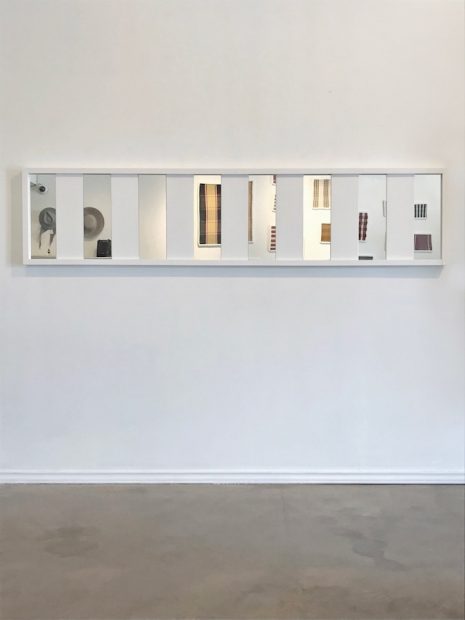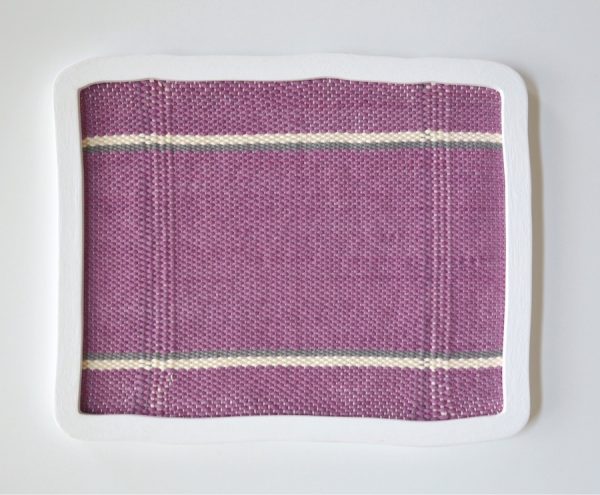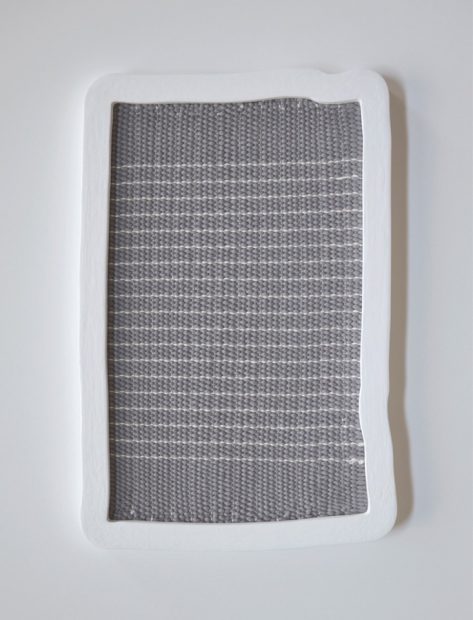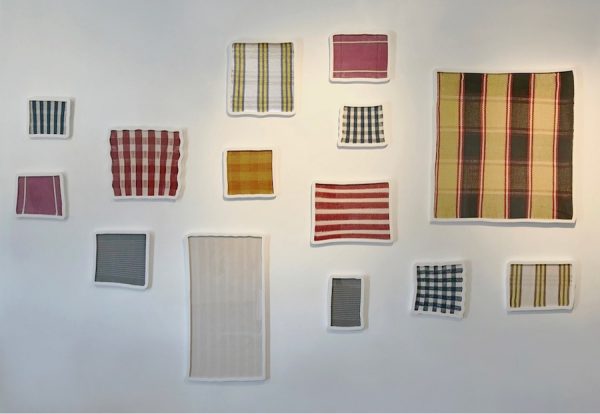
Ana Esteve Llorens, Untitled ( Big Squares Blue ), 2018
(Hand woven cotton and wool, natural Indigo dye, mdf, plexiglass, paint)
12 1/4” x 13 1/4” x 3/4”
I met Ana Esteve Llorens in her Austin studio on the last morning of August, on one of those summer days when you are already sweating before you get out of the car. It was hot, but the tranquil beiges, whites, and light blues in her studio made me forget about the comforts of AC. Esteve Llorens herself is just as refreshing, and is someone I’ve wanted to meet for a while now. Like myself, she lives and works between Texas and Spain, and I’m curious about how these two places inform her practice. And so I was excited to catch the artist’s new exhibition Correspondence at Las Cruxes in Austin before returning to Madrid.
There’s a subtle but compelling tension in Correspondence between labor and art making, between domestic and contemporary art spheres, and between weaving as a craft and as a fine-art technique. Textiles have a long human history, and strong affiliations with utility and women’s work. The plaid design in many of these textiles makes me think of napkins, tablecloths, and clothing — things traditionally made, cared for, and embellished by women. It’s something my grandmother did, and I still see it in my Spanish and Portuguese friends’ moms, aunts, and grandmothers, although few of us maintain the skills that they’ve honed over generations.
The plaid and striped patterns in Esteve Llorens’ weavings form abstract, two-dimensional compositions that hang on the wall in thick white frames. The sides of Esteve Llorens’ frames expertly trace her textiles’ uneven edges, drawing the pieces into the realm of three-dimensional object-ness. Correspondence features a series of woven textiles made with a backstrap loom. It’s a technique in which a portable loom is stretched between the weaver’s body and an anchoring point, like a pillar or a tree. Each bodily movement is impressed directly into the woven fibers, and a unique rhythm and pace develops with each piece according to the weaver’s arm span, endurance, and even, as Esteve Llorens points out, emotional state. And so the scale, pattern, and tension of the final piece are documents of the time and motion that’s passed between body and material, like a private performance or a choreography in thread.

Ana Esteve Llorens, Blinker ( 4 1/2” x 15, 1:1 ), 2018
(Wood, Aluminum, Mirror, Paint)
73 1/4” x 16 1/2” x 1 3/4”
The exhibition is accompanied by a set of emails sent between Esteve Llorens and Amira Pierce, a writer based in New York. The phrase “thinking of making,” from one of the artist’s letters stuck out to me. Thinking of making, making and thinking, thinking and making — weaving is a repetitive process that leaves much room for thought. I remember trying to memorize a piece of writing for a performance, and saying it over and over in my mind everywhere I went, like a prayer. Normally I have a horrible memory, but many moments from my childhood appeared to me as I recited. I imagine that weaving evokes a similarly meditative state. Indeed, Esteve Llorens says that while she is weaving, she sees objects, textures, faces, and meals from familiar places in the past. “In making while remembering,” she says, “I feel like I have been rewriting a story that has been reinforced, but also altered.”

Ana Esteve Llorens, Untitled ( A Horizontal Purple ), 2018
(Hand woven cotton, natural Cochineal and Huizache dyes, mdf, plexiglass, paint)
11 1/4” x 14” x 3/4”
One of the singular aspects of Correspondence is its rich, earthy color palette. Esteve Llorens learned to weave during a residency in Mexico City, and she collected natural elements from different parts of the country to dye her fibers. Zacatlaxcalli fungus from Teotihuacan, Oaxacan indigo, wood from Mérida, and seeds from the Puebla mountains are all infused into the stripes and lines of Esteve Llorens’s pieces. The colors represent a specific moment, what she describes as “a landscape, a temperature, a kind of light, an accent,” in intersecting, overlapping threads. The artist says that she thinks of the concept of place as “an accumulation of experiences, as something that builds up with time.”

Ana Esteve Llorens, Untitled ( A Small Gray ), 2018
(Hand woven cotton, natural Huizache dye, mdf, plexiglass, paint)
8 1/2” x 12 1/8” x 3/4”
Since taking up weaving in the fall of 2015, the artist and her work continue to travel between Spain, Texas, Mexico, and back again. And so the colors in Correspondence have expanded to include elements from Spain. In this way, the artist is physically weaving together her experiences of the two geographies into something new. And that’s what happens when we do the work of making a memory: we always bring things from the present in order to return to a moment in the past.
Through November 11, 2018 at Las Cruxes, Austin




3 comments
A lovely, silky article.
Like combing a xanax thru my hair.
Really enjoyed the description of the work
and the use of Fibers as a fine art material-
especially with the current battle raging
at UNT between arts administration (clueless)
and the highly regarded 60yr old Fibers Depart.
Fibers and its art practice, is set to be jettisoned
and burned like a woman’s work 1950’s dish towel…
Shows, like this one, prove how important Fibers
are to contemporary art. UNT Deans, in your shiny new
70 million dollar arts building monolith to…?
Please take note.
Hear – here- not just memories of women’s work, Nick Cave’s sound suits are part of an expansive and ongoing body of work in which commonplace items such as buttons, plastic hair-beads, domestic textiles and vintage toys are up cycled into elaborate assemblages based on the artist’s own body. It was the textiles that actually grabbed me and almost brought me to tears remembering my grandmother crocheting those doilies.
The fabrics of our lives